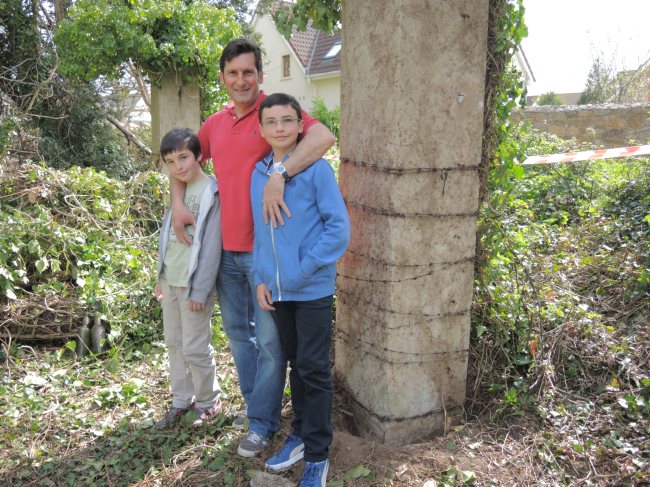Day 8: 12 April 2014. Trench 1 complete
We put in a long session today as we wanted to finish trench 1. We’re more than half way through the project and we still have two more trenches to dig. What I think we have learned from this trench is that, rather than a layer of sand placed on the site by the Germans, as recollected by Occupation veteran Michael Ginns, trench 1 suggests that a layer of hoggin was laid instead, on top of a bed of larger stones. We have some evidence of building debris but not much else.
We were visited by a collector of German militaria, who showed me a couple of artefacts – a German belt buckle and German eagle from a cap – that he had found by metal detecting at another labour camp site in Jersey. While I can say that we have not found anything remotely like that, I do feel concerned that people are taking objects from labour camps in Jersey using metal detectors. Objects taken out of context prevent archaeologists from learning more about a site and ultimately rob a site of its history before it has had a chance to be studied properly. I know full well how popular the collection of German militaria is in the Channel Islands, and has been since the Occupation itself, and have outlined the history of collecting in a chapter in my new book ‘Legacies of Occupation: Heritage, memory and archaeology in the Channel Islands’.
We were also visited on site today by Gary Font and his sons Liam and Pascal (see today’s photo). Gary’s father, Francisco Font, was a Spanish Republican forced and slave labourer who worked in Jersey and Alderney. Francisco married a Jersey woman after the war, as did a handful of other Spanish Republican workers in the island. Gary has taken over the mantle from his father as the Master of Ceremonies at the Westmount forced and slave worker memorial ceremony on Liberation Day (an event at which I gave the speech in 2013), and he is also active on the Holocaust Memorial Day committee in Jersey. It was a pleasure to have him and his sons on site and to show them round, and I hope that visiting the dig has provided Liam and Pascal with some important tangible memories that they will carry with them into the future when they think about the grandfather they never knew.
All members of the Jersey Metal detecting group adhere to strict rules which forbids any detecting on sites of special scientific interest. I can only presume the detectorist who used his detector to locate the German objects, was either unaware of the rules and certainly not a member of our society.
I don’t suppose he was a member …
You are probably correct, there are those that choose Jersey as their holiday destination so as to detect the beaches and other sites. Especially in the summer periods; maybe they should be warned before entering the islands.
I’m afraid it was a local man.